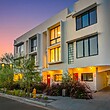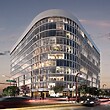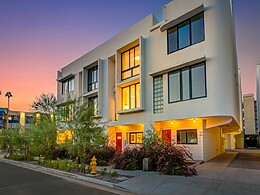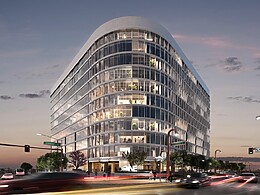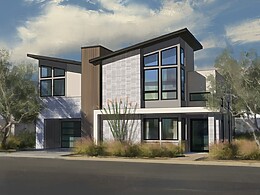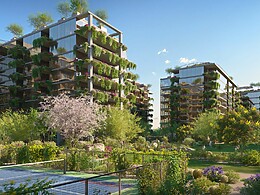By David M. Brown

Canadians may not be coming to the Valley for a while, but Californians are coming on strong.
The Maricopa County luxury market was red hot in a red-hot summer, despite COVID-19 and in some ways because of it. Buyers are from out West and from back East and even in town.
They want bigger homes with new spaces inside and they want homes with more space outside: residential social distancing. They even want more pets. What’s more, they bought in the hottest summer ever recorded in the Phoenix/Scottsdale area. Only Death Valley made the Valley of the Sun look cool.
“In a nutshell, everybody’s staying home, and everybody’s buying a home,” says Frank Aazami, Brand Ambassador, principal of the Private Client Group at Russ Lyon Sotheby’s International Realty, Scottsdale.

“The first thing we’ve noticed is that no one has said, ‘Let’s take our home off the market. Instead, this summer we’ve thrown seasonality conversations out of the window –– despite how hot it was and the pandemic.”
Aazami and his 17-member Private Client Group have been telling their seller clients, “If you don’t list now, the next market may be a different cycle when the lenders’ COVID-19 forbearance program is lifted.”
This has been a good market: Real estate licensees have increased worldwide. In Maricopa County, that total was 87,983 for fiscal year 2019; that increased to 88,616 in fiscal year 2020, based on Arizona Department of Real Estate numbers.
“People are selling their luxury homes here,” Aazami says. “Demand is at a record high.”
A State of Movement, a Statement on Space

The top five states for in-migration to Maricopa County, and a recent monthly tally: California, 4,762; Washington, 1,722; Colorado, 1,292; Illinois, 1,167; and Minnesota, 774 (U.S. Census Bureau). “People still want to come here,” he says. “We have the combination of great weather, jobs and the lifestyle advantages.”
With the Canadian border closed at least until September 21 and the cost of the Canadian dollar low against the American, the regular inter-country trek to the Valley may be cancelled for a while, Aazami explains.
Not so California, which continues to send many buyers of luxury homes across the state border: “They’re tired of politics and policies, taxes and the price of real estate –– and now the pandemic,” says Aazami. “They want privacy and space and they find it here at prices unheard of there.”

And Easterners, many of them snowbirds, are thinking: theaters, closed; restaurants, restricted or closed; sports, playing to cheerless empty seats. They ask: Is that a future, especially now that we have obtained some success in our lives? “And, the high cost of living relative to the Valley is difficult to justify and high-rise living is getting lower and lower on their enjoyment scale,” Aazami says. “They also want the elbow room that we offer abundantly here.”
Jobs to Scottsdale are following the people. “We have been busy servicing these entrepreneurs and top executives find the right Paradise Valley address to call home,” says Aazami.
Valley homeowners buying luxury properties have shifted their home-size goals as well. Pre-COVID-19, they wanted downsizers, less than 5,000 square feet; now they want 6,000 square feet and above, whether the children have fledged or not. Give me space: I can empty nest with more branches around me. “People are saying they cannot spend time in smaller spaces; they feel locked in,” he says.

Because of this, Arizona communities that are particularly strong for luxury sales offer large parcels and open space: Fountain Hills, Carefree/Cave Creek, Gold Canyon, Tucson and Flagstaff. “There’s a shortage of inventory, which is good for sellers, and people are acquiring them to live in, not just for seasonal stays,” Aazami says, noting that his group is also seeing more demand for hillside and multi-acre parcels. “People want space and are buying space.”
Many people are working at home now. Cromford® Associates cites a recent MIT report, documenting that 34.1 percent of pandemic-affected U.S. workers had switched to telecommuting from home beginning in April. Another 14.6 percent told the researchers they were already doing this prior, making 48.7 percent of the workforce home based.
“Employers see how much they can save on high rents, especially in high-dollar spaces with high taxes and parking issues,” Aazami explains. He notes that this may also affect the commercial market, reducing office leases and the footprint size desired.
Add the costs of travel to work, personal safety and insurance. “Business owners are finding that they can be more productive working from home, they’ve had less or no HR-related complaints and their people are liking the arrangement, too,” he says. Many have noticed the impact on traffic and air quality nationwide.

As a result, COVID-19 buyers are asking him for bigger spaces to accommodate two split offices for couples to work from home. They want an exercise room to stay fit in place. And outdoors, they’re listing fenced larger yards with multiple patios.
A guest or pool home is popular, as older parents will be staying with their children; many millennial and Z-gen children will also be remaining in nest longer before breaking away. Larger garages are also requested, including an RV garage, so travel can also be socially distanced. Buyers have even asked for in-ground trampolines and sports courts.
These changes relate to quality of life as much as to pandemic impacts. Aazami says, “They can spend more time with their families, they can balance work/play and even adopt more dogs for companionship.”
Figuring Out the New Market
Aazami notes that Maricopa County broke the mark for average price sold this August, posting $358,279, according to Cromford Associates –– an all-time high. Compare this to the very strong $339,029 for August 2007, just at the verge of the Great Recession, and $157,140, as that bottomed out in October 2011.
Moreover, the number of homes under contract in Maricopa County is up 20 percent year over year for all categories: 13,471 for August 2020 against 10,700 for August 2019, again says Cromford Associates.
“All the factors are there supporting this,” Aazami explains. “Demand for homes exceeds supply; interest rates are low; there’s a housing shortage with public reports up countywide for new housing developments from fiscal year 2019 to fiscal year 2020; we have that high relocation figure; and home priorities have shifted for locals.”

In June 2020, 1,200 homes exceeding $500,000 sold in Maricopa County; in July 2020, that rose to 1,800 sales of $500,000 plus. In August, the county’s total sales volume was $4 billion; compare that to the previous high in 2008, pre-recession, $3.2 billion for the month, according to Cromford Associates.
“Attribute this, too, to a rise in demand and a decline in inventory,” Aazami says. “The fed printed too much money, and this caused hard assets, like brick and mortar, gold and other precious metals to rise in value. It’s unprecedented.”
Another figure: The average year-over-year appreciation rate, August 2019 to August 2020, is 15.2 percent across all areas and types of homes in the county based on the August Cromford Report Daily Observation developed from Arizona Multiple Listing Service (ARMLS) figures, says Mike Balzotti, M.Ed., at RLSIR.
Regarding appreciation, the Daily Observation adds, “Prices are now beginning the powerful surge upward that was predicted when the Cromford Market Index started to rocket skywards in June.”
Breaking down market dynamics further, the Daily Observation suggests: “The age of the home is crucially important because a home that is updated and modern is going to sell for a whole lot more than one that is tired and outdated. This is why fix and flip works, even when the size of the home is unchanged.”
And a final. For Scottsdale, the monthly average sales price (different from appreciation) is showing a 25-percent year-over-year increase. Balzotti: “That’s rather stunning.”

Schedule a one-on-one phone conversation with Frank Aazami now, 480.266.0240, text him, “SIRFAAZAMI” to 87778, email, frank@PCGagents.com, and see PCGagents.com for more information.
Brown is a Valley-based writer (azwriter.com).



